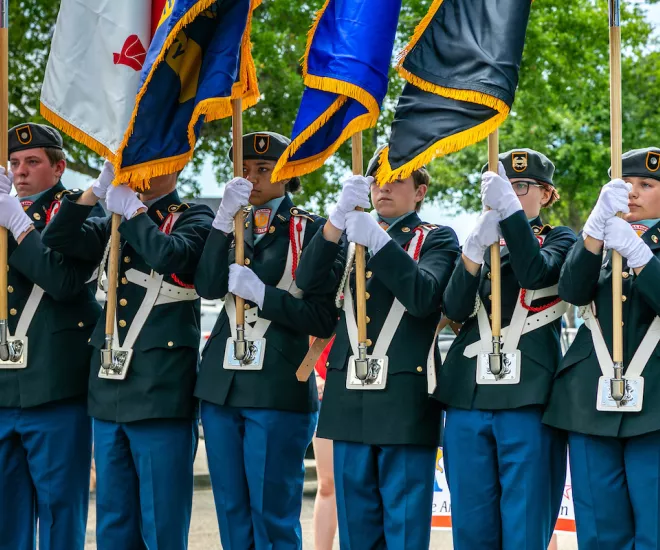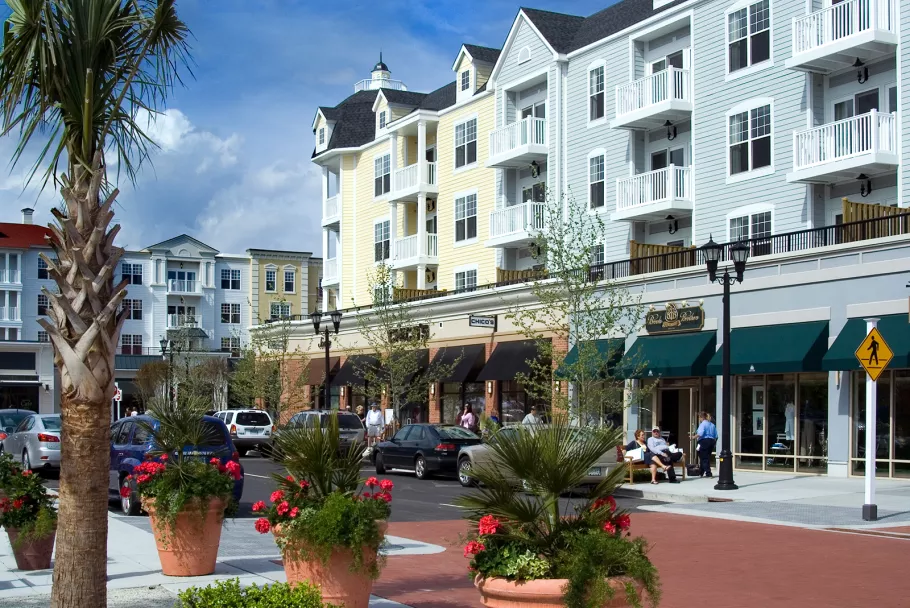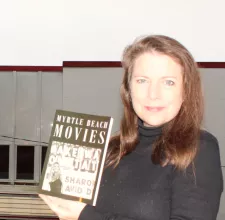Military History of the Myrtle Beach Area

What is now the Market Common District was once the Myrtle Beach Air Force Base. During WWII, it was an Army Air Corp airfield that housed a crucial training facility and eventually a German POW camp.
In March of 1942, The Myrtle Beach Bombing and Gunnery Range opened. It stretched from the coast all the way to what is currently Carolina Forest, just west of Myrtle Beach. On occasion, developers there may find old training ordnances in the sandy soil when creating new neighborhoods. And after every decade or so when our beaches undergo the renourishment process of having sand pumped in from offshore, old bullet casings are sometimes cast on our beach that are remnants of wartime training exercises just off of our coast.
In June of 1944, the first wave of German POWs arrived at the Myrtle Beach train depot downtown. There were approximately 250 in the first group of what would be about 600 who came here by war’s end. They earned at least eighty cents a day (the equivalent to what an American private would make) for their work at the airfield or they could earn more if they boarded work trucks to labor in our area’s lucrative timber industry or on farms throughout Horry County.
The most noticeable homage to that WWII airfield today is one of our city’s newest recreation offerings. In late 1941, there wasn’t time to build the standard brick and mortar buildings that you would normally see on a military installation. Here, we had hastily-built wooden barracks, offices, a hospital, and other needed structures. Consequently, the airmen and locals began to affectionately refer to those buildings as Splinter City. That’s why now at the Kings Highway entrance of the Market Common District, you see the sign for the Splinter City Disc Golf Course, which is free and open to the public.
After the war, the airfield closed in November of 1947, and the federal government handed the land back over to the city of Myrtle Beach which included our municipal airport. It featured two runways that had been built with federal funds which the town procured leading up to our country’s entry into the war. Those military-grade runways were the impetus for having the airfield at this location and later the Air Force base that began construction in 1954.
Meanwhile, when Myrtle Beach took possession of the property again, the town needed to generate income from the land holding in addition to what the airport, which is run by the county, could bring in. They did so by having a travel lodge along Kings Highway, three turkey farms with no fewer than 50,000 turkeys (who soon got used to the noise and were not bothered by the planes at the nearby airport), and a baseball spring training camp.
The players who trained there were from the farm team of the Boston Braves. If you have ever heard of the Boston Braves, it was probably because of one of two reasons. In 1914, they were called “The Miracle Braves” when they went from last place on July 4th to a pennant and a World Series sweep.
Then, on February 26, 1935, on the heels of 40-year-old Babe Ruth’s claim that the Yankees owed him the job of manager as he faced retirement, his ball club adamantly disagreed. In fact, at spring training, they added insult to injury when they reassigned his uniform number, used his locker for firewood and then released him. The Boston Braves signed him that day for a three-year contract, but with the mutual consent of all parties involved, he went ahead and retired three months later.
By the early 1950s, with the Cold War looming, the federal government looked to Myrtle Beach as a prime location to build a new Air Force base. Apparently ready to get out of the turkey and baseball business, our town just gave the property needed on April 1, 1954, and the Myrtle Beach Air Force Base’s construction was underway. Its ceremonial opening was held on December 7, 1956, and the base achieved combat-ready status on July 1, 1958. The Myrtle Beach Air Force Base closed on March 31, 1993, and eventually became the Market Common District that we know today.

To honor the rich military history of the area, the street names within the district reflect the heroes and aircraft that played roles in the events that shaped our storied past during the time each of the bases were here. Most represent those who served during the more modern era, but WWII heroes are the namesakes for the district’s most prominent thoroughfares, Farrow Parkway and Howard Avenue. William Farrow was one of the “Doolittle Tokyo Raiders,” who were the 80 men on 16 B-25s to first bomb Japanese soil after Pearl Harbor. James Howard was a fighter pilot who received the Congressional Medal of Honor when he single-handedly prevented an attack on a formation of B-17 bombers over Germany and shot down five enemy aircraft.
Historic markers are strategically placed along the streets to share the compelling biographies. Large maps are on display in Valor Memorial Gardens and Warbird Park that will guide visitors to the location of specific markers throughout the district that may be of an individual’s particular interest.

Warbird Park itself is one of the most interesting places to visit. It has on static display three aircraft that represent the three eras of the base’s history. The F-100 was flown during the Cold War and the Cuban Missile Crisis. The A-7 D was used in Vietnam. And the A-10 (a.k.a. The Warthog) proved its worth in Desert Storm and is still being used today with modern enhancements.
This park has become the site to honor those who served and those whom we’ve lost. There are military memorials, a new 9/11 remembrance installation and the Wall of Service. If you would like to honor a person who served at this location from 1941 to 1993, either in a military or civilian capacity, contact the City of Myrtle Beach about adding their name to this wall.

If you are an active or retired military member, please check out our Military Discounts packages for your next vacation at The Beach. Thank you for your service!
